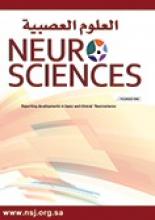Abstract
Intracranial calcification has a variety of etiologies; among those are environmental and metabolic disturbances involving calcium homeostasis. The main environmental factors resulting in intracranial calcification are congenital infections with toxoplasmosis, and cytomegalovirus. There are increasing reports on cases showing pictures of congenital infection in the absence of confirmative positive TORCH screen, and there are many cases reported worldwide sharing the same presentation labeled as autosomal recessive congenital infection-like syndrome or pseudo-TORCH syndrome (OMIM 600158).
- Copyright: © Neurosciences
Neurosciences is an Open Access journal and articles published are distributed under the terms of the Creative Commons Attribution-NonCommercial License (CC BY-NC). Readers may copy, distribute, and display the work for non-commercial purposes with the proper citation of the original work.






